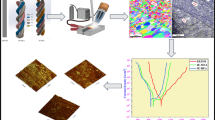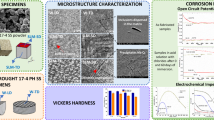Abstract
In this study, the in vitro degradation behaviour of a friction stir processed AZ31 magnesium alloy was investigated. Electrochemical experiments in simulated body fluid suggest that friction stir processing marginally enhances the degradation resistance of the alloy, which could be attributed to the dissolution of secondary phase particles. Homogenisation of the microstructure reduces galvanic corrosion. It is envisaged that the beneficial effect would be more pronounced for magnesium alloys which contain high volume fraction of galvanic corrosion inducing secondary phase particles.



Similar content being viewed by others
References
Witte F, Hort N, Vogt C, Cohen S, Kainer KU, Willumeit R, Feyerabend F. Degradable biomaterials based on magnesium corrosion. Curr Opinion Solid State Mater Sci. 2008;12:63–72.
Staiger PM, Pietak AM, Huadmai J, Dias G. Magnesium and its alloys as orthopedic biomaterials. Biomaterials. 2006;27:1728–34.
Bobby Kannan M, Singh Raman RK. In vitro degradation and mechanical integrity of calcium-containing magnesium alloys in modified-simulated body fluid. Biomaterials. 2008;29:2306–14.
Bobby Kannan M, Singh Raman RK. Evaluating the stress corrosion cracking susceptibility of Mg-Al-Zn alloy in modified-simulated body fluid for orthopaedic implant application. Scripta Mater. 2008;59:175–8.
Bobby Kannan M. Influence of microstructure on the in vitro degradation behaviour of magnesium alloy. Mater Lett. 2010;64:739–42.
Walter R, Bobby Kannan M. In vitro degradation behaviour of WE54 magnesium alloy in simulated body fluid. Mater Lett. 2010;65:748–50.
Bobby Kannan M, He Y, Sandham A. Calcium phosphate deposition on magnesium alloy for bio-implant applications. Mater Sci Forum. 2010;654–656:2196–9.
Bobby Kannan M, Singh Raman RK. A mechanistic study of in vitro degradation of magnesium alloy using electrochemical techniques. J Biomed Mater Res Part A. 2010;93A:1050–5.
Chiu KY, Wong MH, Cheng FT, Man HC. Characterization and corrosion studies of fluoride conversion coating on degradable Mg implants. Surf Coat Technol. 2007;202:590–8.
Ma ZY, Pilchak AL, Juhas MC, Willams JC. Microstructural refinement and property enhancement of cast light alloys via friction stir processing. Scripta Mater. 2008;58:361–6.
Bobby Kannan M, Dietzel W, Zeng R, Zettler R, dos Santos JF. A study on the SCC susceptibility of friction stir welded AZ31 Mg sheet. Mater Sci Eng A. 2007;460–461:243–50.
Ni DR, Xiao BL, Ma ZY, Qiao YX, Zheng YG. Corrosion properties of friction-stir processed cast NiAl bronze. Corros Sci. 2010;52:1610–7.
Oyane A, Kim H, Furuya T, Kokubo T, Miyazaki T, Nakamura TJ. Preparation and assessment of revised simulated body fluids. Biomed Mater Res A. 2003;65:188–95.
Park SHC, Sato YS, Kokawa H. Effect of micro-texture on fracture location in friction stir weld of Mg alloy AZ61 during tensile test. Scripta Mater. 2003;49:161–6.
Xunhong W, Kuaishe W. Microstructure and properties of friction stir butt-welded AZ31 magnesium alloy. Mater Sci Eng A. 2006;431:114–7.
Datong Z, Suzuki M, Maruyama K. Microstructural evolution of a heat-resistant magnesium alloy due to friction stir welding. Scripta Mater. 2005;52:899–903.
Fernández-Sánchez C, McNeil CJ, Rawson K. Electrochemical impedance spectroscopy studies of polymer degradation: application to biosensor development. Trends Anal Chem. 2005;24:37–48.
Baril G, Pebere N. The corrosion of pure magnesium in aerated and deaerated sodium sulphate solutions. Corros Sci. 2001;43:471–84.
Jin S, Amira S, Ghali E. Electrochemical impedance spectroscopy evaluation of the corrosion behaviour of die cast and tixocast AXJ530 Mg alloy in chloride solution. Adv Eng Mater. 2007;9:75–83.
Zhao MC, Liu M, Song G, Atrens A. Influence of the β-phase morphology on the corrosion of the Mg Alloy AZ91. Corros Sci. 2008;50:1939–53.
Acknowledgments
The authors would like to express their gratitude to J.F. dos Santos for providing the friction stir processed samples. Thanks are also due to R. Walter and E.Koc for their help in the electrochemical experiments.
Author information
Authors and Affiliations
Corresponding author
Rights and permissions
About this article
Cite this article
Bobby Kannan, M., Dietzel, W. & Zettler, R. In vitro degradation behaviour of a friction stir processed magnesium alloy. J Mater Sci: Mater Med 22, 2397–2401 (2011). https://doi.org/10.1007/s10856-011-4429-x
Received:
Accepted:
Published:
Issue Date:
DOI: https://doi.org/10.1007/s10856-011-4429-x




